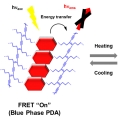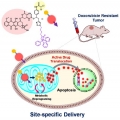| 첨부 '1' |
|---|
| author | Jong Seung Kim |
|---|---|
| journal | Acc. Chem. Res., 2015, 48 (11), pp 2935–2946 |
| Homepage | http://orgchem.korea.ac.kr/index2.asp |
Theranostics, chemical entities designed to combine therapeutic effects and imaging capability within one molecular system, have received considerable attention in recent years. Much of this interest reflects the promise inherent in personalized medicine, including disease-targeted treatments for cancer patients. One important approach to realizing this latter promise involves the development of so-called theranostic conjugates, multicomponent constructs that selectively target cancer cells and deliver cytotoxic agents while producing a readily detectable signal that can be monitored both in vitro and in vivo. This requires the synthesis of relatively complex systems comprising imaging reporters, masked chemotherapeutic drugs, cleavable linkers, and cancer targeting ligands. Ideally, the cleavage process should take place within or near cancer cells and be activated by cellular components that are associated with cancer states or specifically expressed at a higher level in cancer cells. Among the cleavable linkers currently being explored for the construction of such localizing conjugates, disulfide bonds are particularly attractive. This is because disulfide bonds are stable in most blood pools but are efficiently cleaved by cellular thiols, including glutathione (GSH) and thioredoxin (Trx), which are generally found at elevated levels in tumors. When disulfide bonds are linked to fluorophores, changes in emission intensity or shifts in the emission maxima are typically seen upon cleavage as the result of perturbations to internal charge transfer (ICT) processes. In well-designed systems, this allows for facile imaging. In this Account, we summarize our recent studies involving disulfide-based fluorescent drug delivery conjugates, including preliminary tests of their biological utility in vitro and in vivo.
To date, a variety of chemotherapeutic agents, such as doxorubicin, gemcitabine, and camptothecin, have been used to create disulfide-based conjugates, as have a number of fluorophores, including naphthalimide, coumarin, BODIPY, rhodol, and Cy7. The resulting theranostic core (drug−disulfide−fluorophore) can be further linked to any of several site-localizing entities, including galactose, folate, biotin, and the RGD (Arg-Gly-Asp) peptide sequence, to create systems with an intrinsic selectivity for cancer cells over normal cells. Site-specific cleavage by endogenous thiols serves to release the cytotoxic drug and produce an easy-to-monitor change in the fluorescence signature of the cell. On the basis of the results summarized in this Account, we propose that disulfide-based cancer-targeting theranostics may have a role to play in advancing drug discovery efforts, as well as improving our understanding of cellular uptake and drug release mechanisms.

http://pubs.acs.org/doi/abs/10.1021/acs.accounts.5b00406
-
Read More

Covalently Linked Perylene Diimide–Polydiacetylene Nanofibers Display Enhanced Stability and Photocurrent with Reversible FRET Phenomenon
Because of their unique structural and optical properties, 1D perylene diimide (PDI) derivatives have gained attention for use in optoelectronic devices. However, PDI‐containing self‐assembled supramolecular systems often are of limited use ... -
Read More

Blue Emission of α-GaN Colloidal Quantum Dots via Zn Doping
Yun Chang Choi(최윤창, 제1저자) Gallium nitride (GaN) has been of interest due to its enormous potentials for optoelectronic devices. However, it is very interesting that no proper bottom-up chemical synthesis method for GaN quantum dot has... -
Read More

Gas phase conformations of intrinsically disordered proteins and their complexes with ligands: Kinetically trapped states during transfer from solution to the gas phase
Jong Yoon Han(한종윤, 제1저자, 박사과정) Flexible structures of intrinsically disordered proteins (IDPs) are crucial for versatile functions in living organisms, which involve interaction with diverse partners. Electrospray ionization ion m... -
Read More

Multifunctional Self-Doped Nanocrystal Thin-Film Transistor Sensors
Dongsun Choi(제1저자, 통합과정) Self-doping in nanocrystals allows accessing higher quantum states. The electrons occupying the lowest energy state of the conduction band form a metastable state that is very sensitive to the electrostatic p... -
Read More

Fine-tuning of wettability in a single metal–organic framework via postcoordination modification and its reduced graphene oxide aerogel for oil–water separation
Sunhwi Eom(제1저자) Elaborate control of wettability in a single platform is essential for materials’ applications towards oil–water separation, but it still remains challenging. Herein, we performed postcoordination modification of Mg2(dob... -
Read More

Harnessing Intramolecular Rotation to Enhance Two‐photon Imaging of Aβ Plaques Through Minimizing Background Fluorescence
Jinwoo Shin(제1저자 석박통합과정) The aggregation of Aβ‐proteins in senile plaques is a critical event during the development of Alzheimer’s disease, and the postmortem detection of Aβ‐rich proteinaceous deposits via fluorescent staining re... -
Read More

Proteogenomic Characterization of Human Early-Onset Gastric Cancer
Dong-Gi Mun(제1저자, 박사과정) We report proteogenomic analysis of diffuse gastric cancers (GCs) in young populations. Phosphoproteome data elucidated signaling pathways associated with somatic mutations based on mutation-phosphorylation co... -
Read More

Chemiluminescent Probe for the In Vitro and In Vivo Imaging of Cancers Over-Expressing NQO1
Activatable (turn-on) probes that permit the rapid, sensitive, selective, and accurate identification of cancer-associated biomarkers can help drive advances in cancer research. Herein, a NAD(P)H:quinone oxidoreductase- 1 (NQO1)-specific ch... -
Read More

Molecularly Controlled Stark Effect Induces Significant Rectification in Polycyclic Aromatic Hydrocarbon-terminated n-Alkanethiolates
Soo Jin Cho(제1저자, 석박통합과정) Gyu Don Kong(공동 제1저자, 박사과정) Variation of electronic structure of individual molecules as a function of applied bias matters for performance of molecular and organic electronic devices. Understandi... -
Read More

A New Approach for Large-Area Thermoelectric Junctions with Liquid Eutectic Gallium-Indium Electrode
Sohyun Park(박소현, 통합과정, 제1저자) A challenge in organic thermoelectrics is to relate thermoelectric performance of devices to the chemical and electronic structures of organic component inside them on a molecular scale. To this end, a... -
Read More

Nanometric Water Channels in Water-in-Salt Lithium Ion Battery Electrolyte
Joonhyung Lim(임준형, 박사과정, 제1저자) Lithium-ion batteries (LIBs) have been deployed in a wide range of energy-storage applications and helped to revolutionize technological development. Recently, a lithium ion battery that uses superco... -
Read More

Topotactic Transformations in an Icosahedral Nanocrystal to Form Efficient Water-Splitting Catalysts
Designing high‐performance, precious‐metal‐based, and economic electrocatalysts remains an important challenge in proton exchange membrane (PEM) electrolyzers. Here, a highly active and durable bifunctional electrocatalyst for PEM electroly... -
Read More

Fluorescence enhancement of a ligand-activated fluorescent protein induced by collective noncovalent interactions
Euihyun Lee(이의현, 박사과정, 제1저자) Fluorescent proteins contain an internal chromophore constituted of amino acids or an external chromophore covalently bonded to the protein. To increase their fluorescence intensities, many research gr... -
Read More

Elucidating the Role of Molecule-Electrode Interfacial Defects in Charge Tunneling Characteristics of Large-area Junctions
Gyu Don Kong(공규돈, 박사과정, 제1저자) / Junji Jin(김준길, 석사과정, 제2저자) Interfacial chemistry at organic-inorganic contact critically determines function of a wide range of molecular and organic electronic devices and other systems. ... -
Read More

PDMS-Coated Hypercrosslinked Porous Organic Polymers Modified via Double Postsynthetic Acidifications for Ammonia Capture
Dong Won Kang(강동원, 통합과정, 제1저자) / Minjung Kang(강민정, 통합과정, 제2저자) A hypercrosslinked porous organic polymer was modified by post-oxidation and post-sulfonation to obtain a porous platform with high density of acidic groups.... -
Read More

Accurate Quantification of N-glycolylneuraminic Acid in Therapeutic Proteins Using Supramolecular Mass Spectrometry
Hyun Hee L. Lee (이현희, 박사과정, 제1저자) / Chae Eun Heo (허채은, 박사과정, 제 2저자) Practical applications of innovative host-guest systems are challenging because of unexpected guest competitors and/or subtle environmental differences.... -
Read More

Overcoming Drug Resistance by Targeting Cancer Bioenergetics with an Activatable Prodrug
Nearly without exception, all known cancer chemotherapeutics elicit a resistance response over time. The resulting resistance is correlated with poor clinical outcomes. Here we report a new approach to overcoming resistance that involves rep... -
Read More

Janus Nanoparticle Structural Motif Control via Asymmetric Cation Exchange in Edge-Protected Cu1.81S@IrxSy Hexagonal Nanoplates
Post-synthetic transformation of nanoparticles has received great attention, because this approach can provide an unusual route to elaborately composition-controlled nanostructures while maintaining the overall structure of the template. In... -
Read More

Deconvolution of Tunneling Current in Large-area Junctions Formed with Mixed Self-Assembled Monolayers
Junji Jin(석사과정) Gyu Don Kong(박사과정) Whereas single-component self-assembled monolayers (SAMs) have served widely as organic components in molecular and organic electronics, how the performance of the device is influenced by the hetero... -
Read More

Electron heating and thermal relaxation of gold nanorods revealed by two-dimensional electronic spectroscopy
To elucidate the complex interplay between the size and shape of gold nanorods and their electronic, photothermal, and optical properties for molecular imaging, photothermal therapy, and optoelectronic devices, it is a prerequisite to charac...

